PONTIAC BONNEVILLE 1998 Owners Manual
Manufacturer: PONTIAC, Model Year: 1998, Model line: BONNEVILLE, Model: PONTIAC BONNEVILLE 1998Pages: 395, PDF Size: 17.6 MB
Page 281 of 395
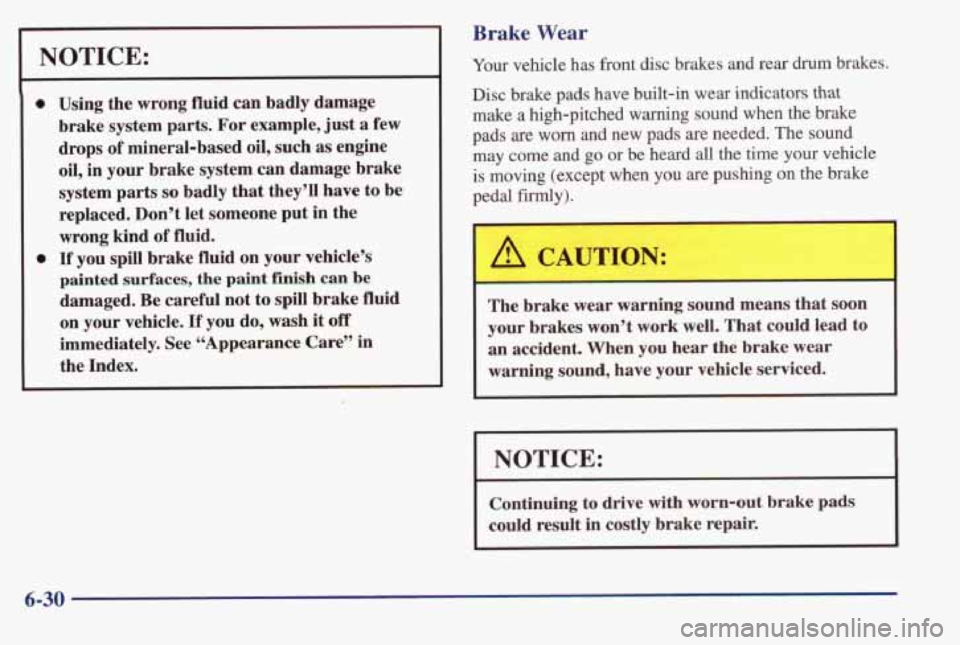
-
NOTICE:
0
0
Using the wrong fluid can badly damage
brake system parts. For example, just a few
drops
of mineral-based oil, such as engine
oil, in your brake system can damage brake
system parts
so badly that they’ll have to be
replaced. Don’t let someone put in the
wrong kind
of fluid.
If you spill brake fluid on your vehicle’s
painted surfaces, the paint finish can be
damaged. Be careful not to spill brake fluid
on your vehicle. If you do, wash it off
immediately. See “Appearance Care” in
the Index.
Brake Wear
Your vehicle has front disc brakes and rear drum brakes.
Disc brake pads have built-in wear indicators
that
make a high-pitched warning sound when the brake
pads are worn and new pads are needed. The sound
may come
and go or be heard all the time your vehicle
is moving (except when
you are pushing on the brake
pedal
firmly).
A 3
,A CAUTION:
I I
The brake wear warning sound means that soon
your brakes won’t work well. That could lead to
an accident. When you hear the brake wear
warning sound, have your vehicle serviced.
I I
I NOTICE: I ~
Continuing to drive with worn-out brake pads
could result
in costly brake repair. I
6-30
Page 282 of 395
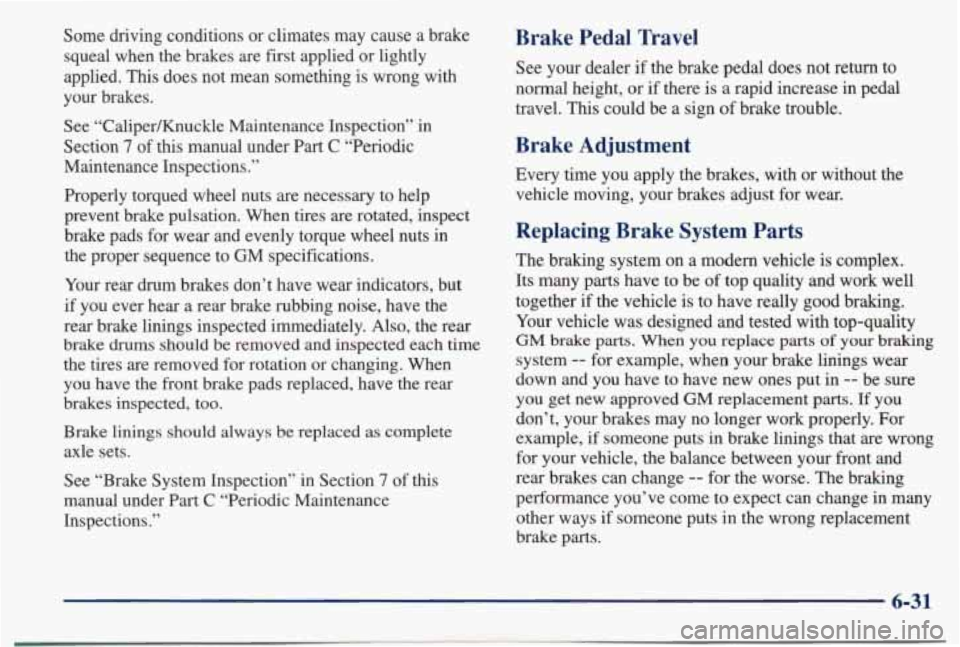
Some driving conditions or climates may cause a brake
squeal when the brakes are first applied or lightly
applied.
This does not mean something is wrong with
your brakes.
See “CaliperKnuckle Maintenance Inspection” in
Section
7 of this manual under Part C “Periodic
Maintenance Inspections.”
Properly torqued wheel nuts are necessary to help
prevent brake pulsation. When tires are rotated, inspect brake pads for wear and evenly torque wheel nuts in
the proper sequence to
GM specifications.
Your rear drum brakes don’t have wear indicators, but
if you ever hear a rear brake rubbing noise, have the
rear brake linings inspected immediately. Also, the rear
brake drums should be removed
and inspected each time
the tires are removed for rotation or changing. When
you have the front brake pads replaced, have the rear
brakes inspected, too.
Brake
linings should always be replaced as complete
axle sets.
See “Brake System Inspection” in Section
7 of this
manual under Part C “Periodic Maintenance
Inspections.”
Brake Pedal Travel
See your dealer if the brake pedal does not return to
normal height, or if there is
a rapid increase in pedal
travel.
This could be a sign of brake trouble.
Brake Adjustment
Every time you apply the brakes, with or without the
vehicle moving, your brakes adjust for wear.
Replacing Brake System Parts
The braking system on a modern vehicle is complex.
Its many parts have to be
of top quality and work well
together if the vehicle is to have really good braking. Your vehicle was designed and tested with top-quality
GM brake parts. When you replace parts of your braking
system -- for example, when your brake linings wear
down and you have to have new ones put
in -- be sure
you get new approved
GM replacement parts. If you
don’t, your brakes may no longer work properly. For example,
if someone puts in brake linings that are wrong
for your vehicle, the balance between your front and
rear brakes can change
-- for the worse. The braking
performance you’ve come to expect can change in many
other ways if someone puts in the wrong replacement
brake parts.
6-31
Page 283 of 395
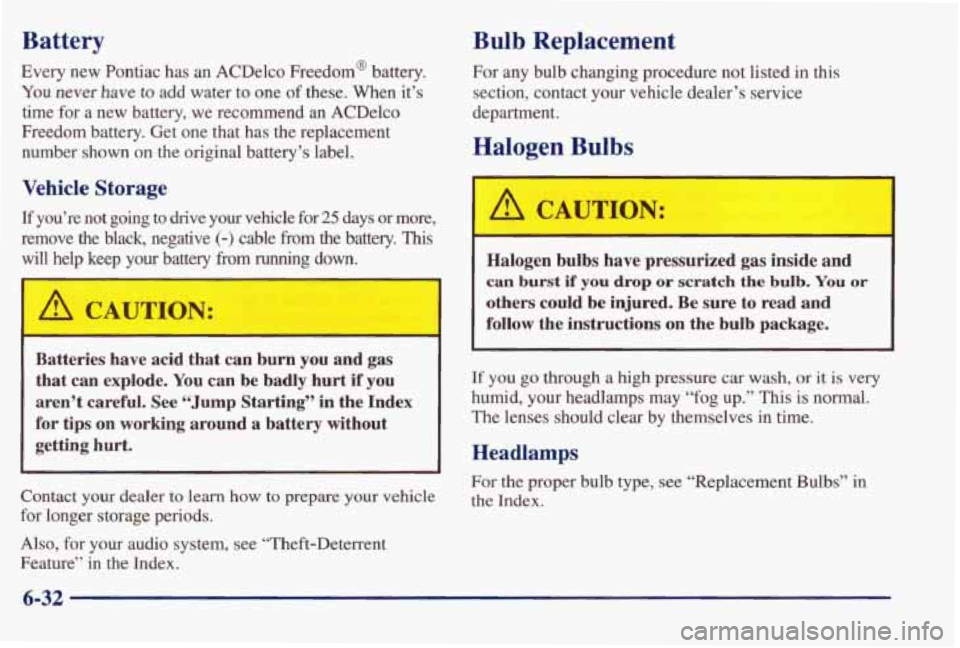
Battery
Every new Pontiac has an ACDelco Freedom@ battery.
You never have to add water to one of these. When it’s
time for a new battery, we recornend
an ACDelco
Freedom battery. Get one that has the replacement
number shown on the original battery’s label.
Bulb Replacement
For any bulb changing procedure not listed in this
section, contact your vehicle dealer’s service
department.
Halogen Bulbs
Vehicle Storage
If you’re not going to drive your vehicle for 25 days or more,
remove the black, negative (-) cable from the battery. This
will help keep your battery fiom running down.
I A CAUTION:
Batteries have acid that can burn you and gas
that can explode. You can be badly hurt if you
aren’t careful. See “Jump
Starting” in the Index
for tips on working around
a battery without
getting hurt.
1
Contact your dealer to learn how to prepare your vehicle
for longer storage periods.
Also, for your audio system, see “Theft-Deterrent
Feature”
in the Index.
A CAUTION:
Halogen bulbs have pressurized gas inside and
can burst if you drop or scratch the bulb. You or
others could be injured. Be sure to read and
follow the instructions on the bulb package.
If you go through a high pressure car wash, or it is very
humid, your headlamps may “fog up.”
This is normal.
The lenses should clear by themselves in time.
Headlamps
For the proper bulb type, see “Replacement Bulbs’’ in
the Index.
6-32
Page 284 of 395
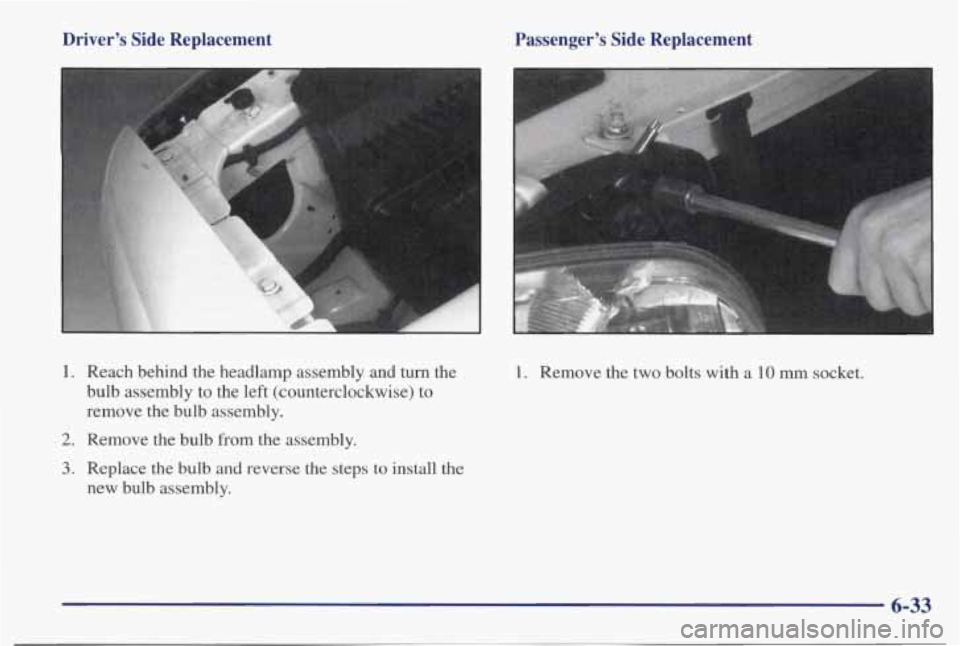
Driver’s Side Replacement
1. Reach behind the headlamp assembly and turn the bulb assembly to the left (counterclockwise) to
remove the bulb assembly.
2. Remove the bulb from the assembly.
3. Replace the bulb and reverse the steps to install the
new bulb assembly.
Passenger’s Side Replacement
-
1. Remove the two bolts with a 10 mm socket.
6-33
Page 285 of 395
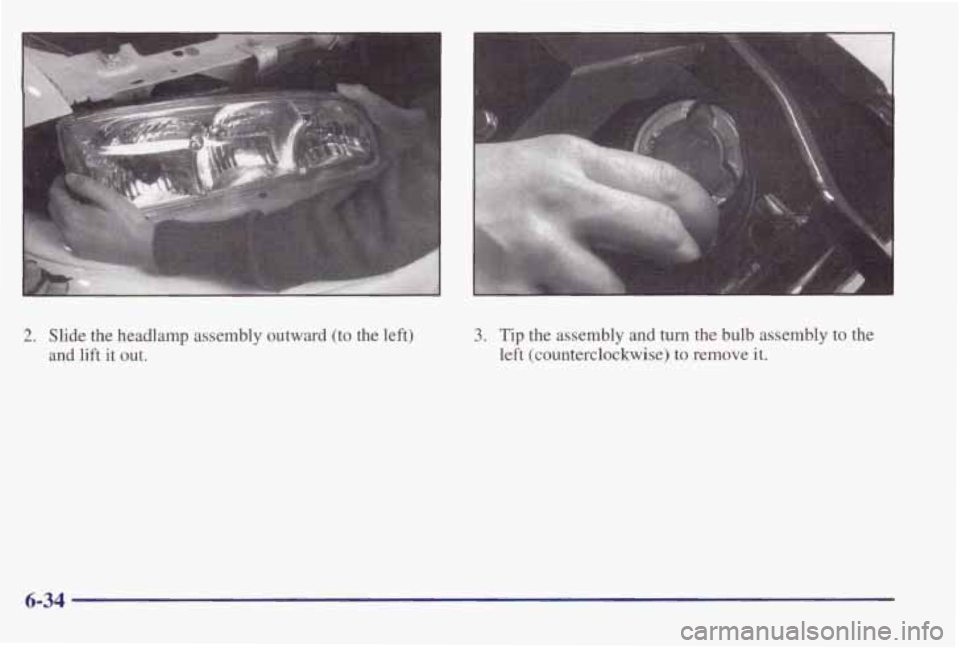
2. Slide the headlamp assembly outward (to the left)
and lift it out. 3. Tip the assembly and turn the bulb assembly to the
left (counterclockwise)
to remove it.
6-34
Page 286 of 395
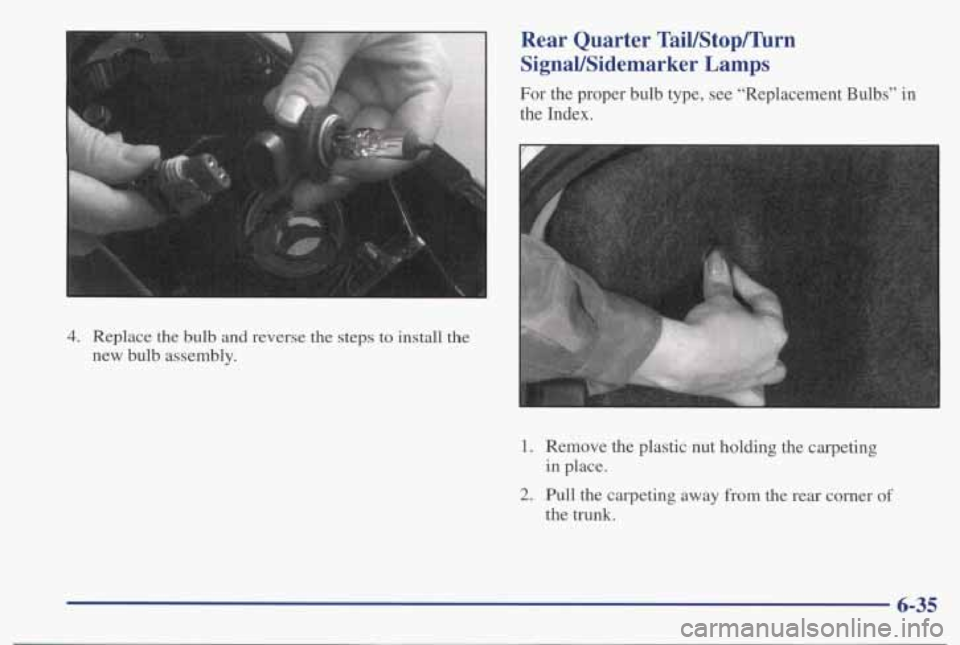
4. Replace the bulb and reverse the steps to install the
new bulb assembly.
Rear Quarter TaiUStophrn
SignaVSidemarker Lamps
For the proper bulb type, see “Replacement Bulbs” in
the Index.
1. Remove the plastic nut holding the carpeting
in place.
2. Pull the carpeting away from the rear corner of
the trunk.
6-35
Page 287 of 395
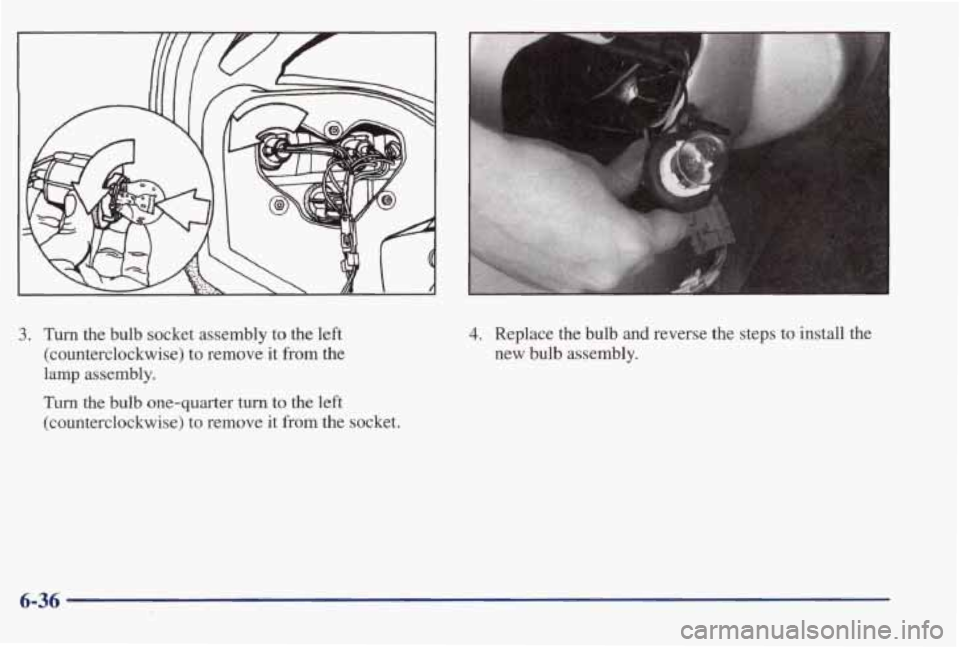
3. Turn the bulb socket assembly to the left
(counterclockwise) to remove it from the
lamp assembly.
Turn the bulb one-quarter turn to the left
(counterclockwise) to remove
it from the socket.
4. Replace the bulb and reverse the steps to install the
new bulb assembly.
6-36
Page 288 of 395
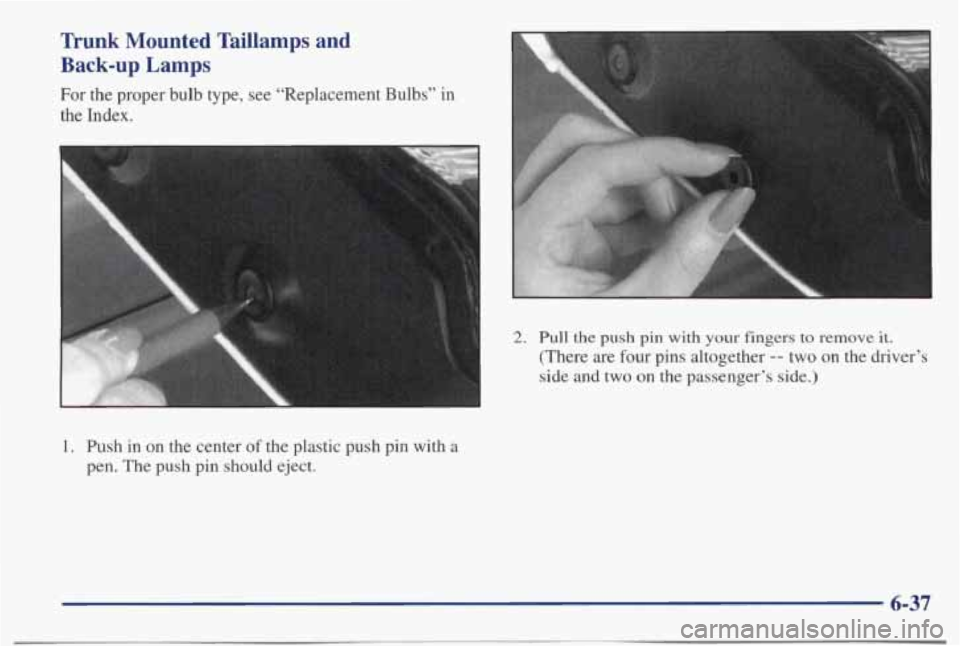
Trunk Mounted Taillamps and
Back-up Lamps
For the proper bulb type, see “Replacement Bulbs” in
the Index.
I
2. Pull the push pin with your fingers to remove it.
(There are four pins altogether -- two on the driver’s
side and two
on the passenger’s side.)
1. Push in on the center of the plastic push pin with a
pen. The push pin should eject.
6-37
Page 289 of 395
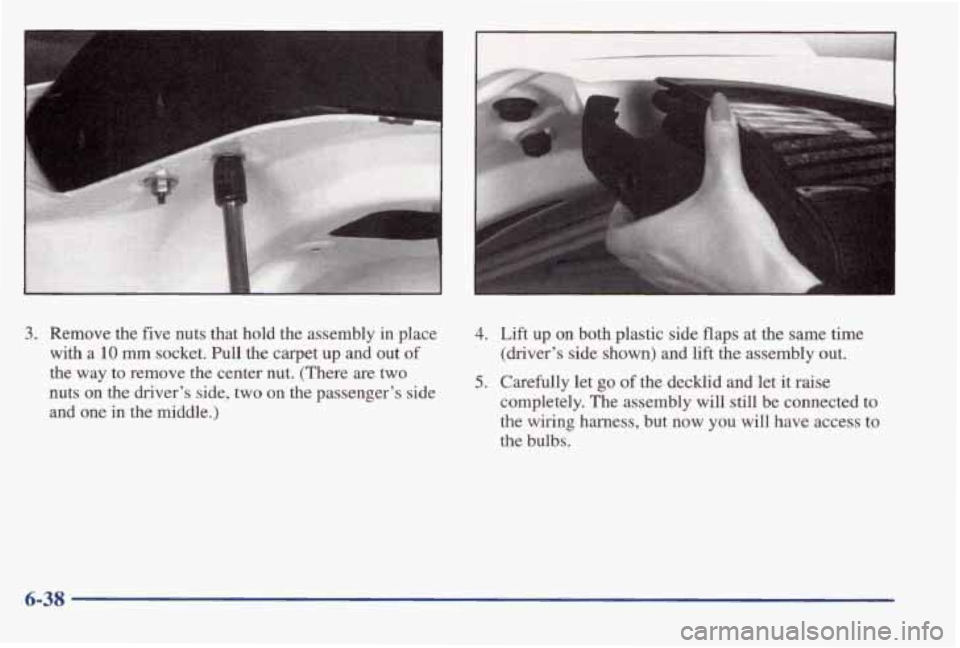
3. Remove the five nuts that hold the assembly in place
with a
10 mm socket. Pull the carpet up and out of
the way to remove the center nut. (There are two
nuts
on the driver's side, two on the passenger's side
and one in
the middle.)
4. Lift up on both plastic side flaps at the same time
(driver's side shown) and lift
the assembly out.
5. Carefully let go of the decklid and let it raise
completely. The assembly will still be connected to
the wiring harness, but now you will have access to
the bulbs.
6-38
Page 290 of 395
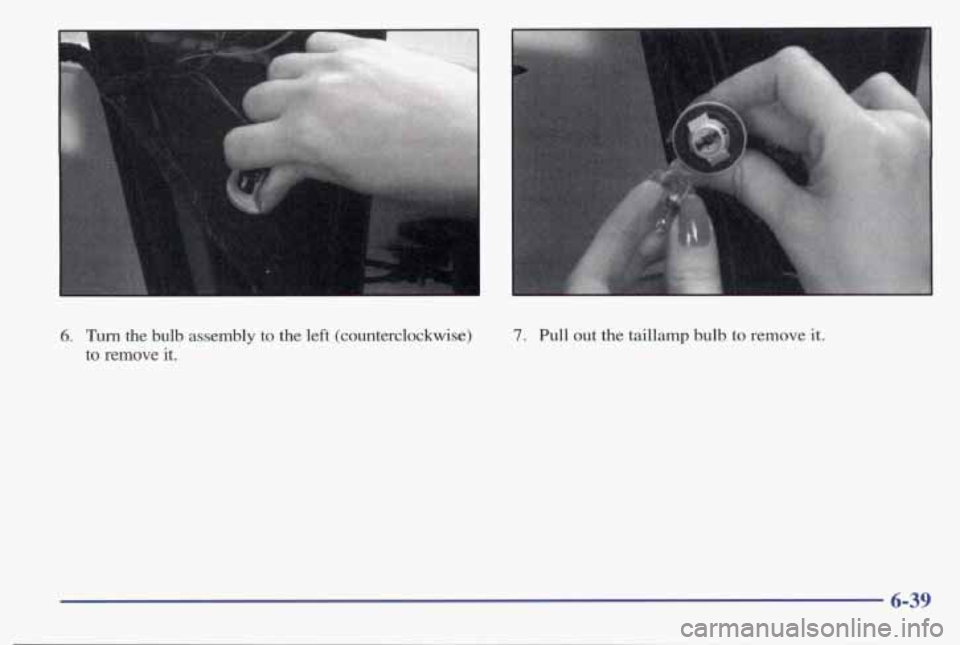
6. Turn the bulb assembly to the left (counterclockwise)
to
remove it.
1
7. Pull out the taillamp bulb to remove it.
6-39